Search Results for 'National Library'
30 results found.
The ‘amusements’ in the Fairgreen
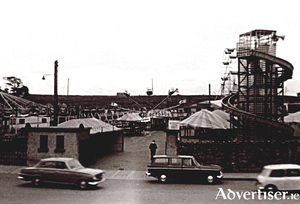
It is good to see the funfair being set up at the moment along the Prom, a sure sign that the summer is on the way. There has been a history of summer funfairs in Galway for well over 100 years, though they were always known here as ‘the amusements’. In the early days, the Toft family used to organise them in Salthill Park. Occasionally, the neighbours used to object to the noise and the traffic, and on at least one occasion, they were invited next door on to the site in front of Dr O’Beirne’s house (where Leisureland is today).
The egg and butter market in Church Street
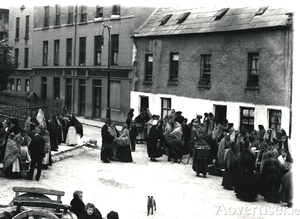
Some weeks ago we wrote about the virtues of country butter being sold at the Saturday Market, but it seems there were occasional vices there too. The ink was hardly dry on the paper when David Barrett sent us an account of a court case that took place at the Galway Petty Sessions in September 1910 before the magistrates Messrs J Kilbride and JS Young. District Inspector Hildebrand prosecuted Mrs Sarah Bane, Moycullen, on three different counts of selling butter that was unfit for human consumption to Kate Hoare, Mary Griffin, and Norah Joyce. Mr Cooke, from Blake and Kenny solicitors, appeared for the defence.
Claddagh fishermen
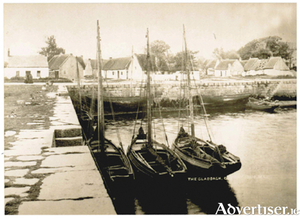
When the Claddagh fishermen worked, they did it with a will, and when not fishing, they were generally found mending their nets. They had the reputation of being so well prepared for sea, that lives were seldom lost when they went fishing. The strand often presented a lively sight at The Claddagh preparatory to the men proceeding to sea. They usually brought with them some oatmeal cakes, potatoes, water, and firing, no spirits of any kind.
Lenaboy Avenue, c1890
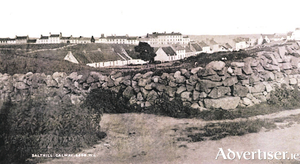
This photograph was taken from the top of Dalysfort Road (which seems to have been little more than a track at the time) and shows Lenaboy Avenue at the bottom of the hill and part of the main Salthill Road in the distance. Most of the buildings in the avenue were part of the Whaley Estate. Many of the occupants were fishermen and many of them had seaweed rights which were quite valuable at the time. The avenue was a main pathway to the shore for people living inland at the time.
Conference exploring the life of James Hack Tuke

JAMES HAKE Tuke, who initiated an assisted emigration scheme, known as the ‘Tuke Fund’, that supported nearly 10,000 people leaving the western seaboard for a better life in America and Canada, will be remembered in Galway at a special two-day event.
The Lynch window
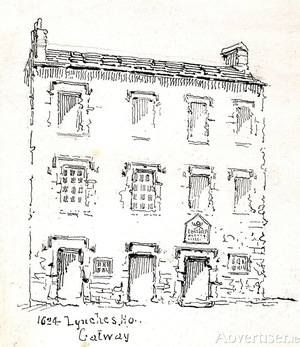
In 1807, the Reverend Edward Mangin wrote a three-volume romantic novel entitled George the Third in which he headed one of the chapters “Which would not have appeared had it not been written”. In it he invented a story about the Mayor of Galway, James Lynch Fitzstephen, hanging his son. Thirteen years later James Hardiman published his History of Galway in which he slightly changed, and greatly elaborated on, the story. This gave Mangin’s story a much wider audience, especially in this country, and so the legend became history. It was copied by many writers over the last 200 years, books written, plays written, films made, etc.
Banks Castle
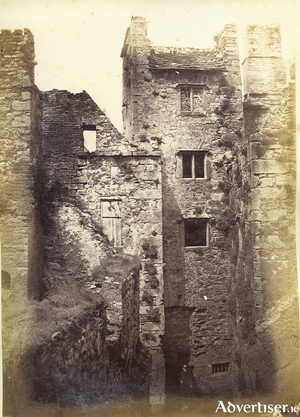
We came across this drawing in the National Library titled “A narrow street in Galway, c.1840-1850”. The clue is in the handwriting at the top of the image, ‘Castle Bank’. In fact, it was a courtyard, not a street, looking at the back of Banks Castle off High Street. Our photograph (courtesy of the Chetham Library in Manchester), shows us much the same view about 25 years later. The property is now part of the King’s Head.
Galway Courthouse c1870
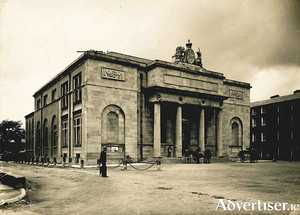
“This fine building, which is superior to most provincial seats of justice, stands at Newtown-Smith, on the site of the ancient and venerable abbey of the Franciscans, which by the Charter of Charles II ‘is to be and remain part of the County of Galway forever’. It was commenced in 1812, and on 1st of April, 1815, was opened for the reception of the then going judges of assize.
The Galway Mechanics’ Institute 1838-2018
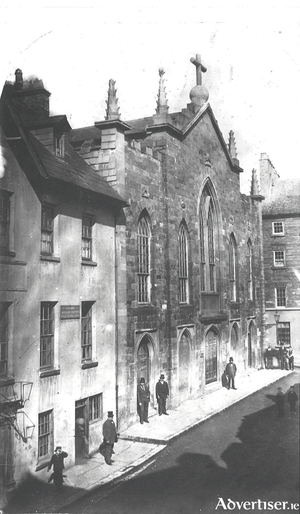
Mechanics’ institutes originated in Scotland in the 1820s. In 1826 a committee formed the first such institute in Galway when it set out a library and newspaper reading room in the ballroom of the Corn Exchange in Eyre Square. Its primary aim was educational and it had rules prohibiting discussion of politics and religion. Difficulties arose when some of the patrons of the facility presumed they could tell the members how to vote in an election and so the institute collapsed.
The Columban Hall
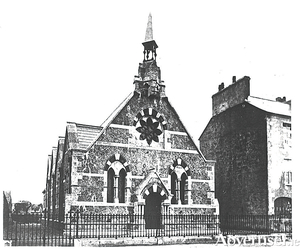
The Columban Hall is described as a bizarre high-Victorian building with a gabled facade of opus incertum with a small porch, polychrome arches to the windows, a star shaped west window, and a curious chunky top-knot. It was originally built as a Congregational Church, designed by Raffles Brown and completed in 1863. Our photograph (courtesy of the National Library) was taken just a few years later.

